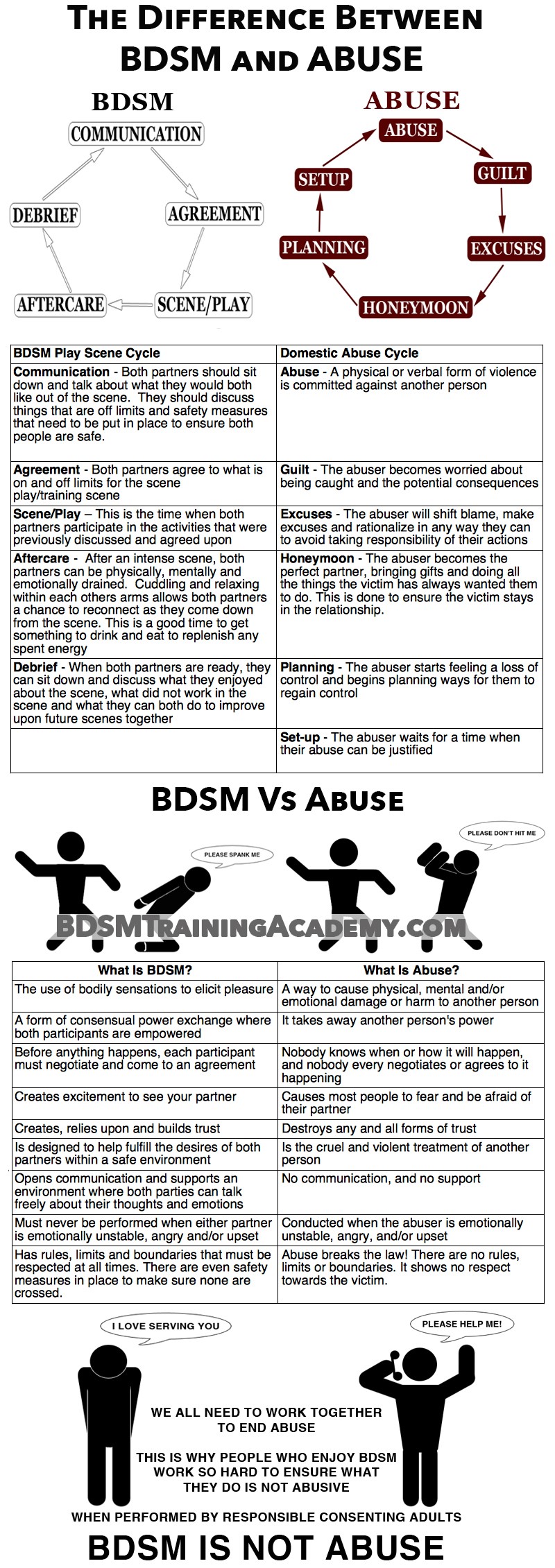Finding My Dream Dom
I’m not the first and I certainly won’t be the last person to write about the differences between BDSM and abuse.
Years ago, I had actively sought out single Doms for relationships. I had a few good experiences that didn’t pan out for personal or compatibility reasons. I immediately weeded out a ton of dickheads and clueless wannabes before there was ever a hope of exchanging phone calls or meeting in person. I also chatted or met with about a half-dozen men who scared me so badly that I ended and blocked contact with them every way I knew how. They just wanted to verbally and/or physically abuse women.
I don’t mean to sound melodramatic about some of the horrible men I came across in my life. If I had the information and contacts that I have now about what is truly, safe, sane and consensual (SSC), I would have never let things get as far as they went. There’s a lot more good credible information available about BDSM now than when I was looking for the Dom of my dreams years ago, but I still see bad information floating around.
Some Subs Don’t Even Know They Are Being Abused
Ironically, some of the worst offenders are usually in some sub-to-sub online discussion forums where the most influential posters have no idea or refuse to believe that they’re being abused. They talk about large, deep patches of bruises and welts like badges of honor. They insist that they’ll do anything their Doms tell them to without question in order to make them happy. And I don’t think I have to explain how lots of people pick up “everything they know” about BDSM from the media, erotica and porn.
It’s easy for people to pick up mixed messages. On the surface, BDSM can look like abuse. Restraints and pain implements like whips, floggers and canes may be used to inflict pain but as long as it induces or incorporated with pleasurable sensual experience.
Terms like “humiliation” and “degradation” may be used, but only to push psychological limits in a controlled way with mutual sexual satisfaction. Words like “whore”, “bitch” and “slut” may be used to evoke a partner’s deeply buried and uncensored sexual side. But if you don’t feel like you’re getting a sexual thrill or feel good or liberated about taking part in activities like that, evaluate how you feel and what’s going on in your BDSM relationship in these following ways.
BDSM is based on consent. It’s not consent if…
- You did not expressly give consent.
- You were afraid to say “No”.
- You say, “Yes,” to avoid conflict or to avoid consequences like losing a job or being outed.
- You cannot withdraw consent and stop what’s happening at any time.
- You cannot express limits and needs without being ridiculed, criticized or being coerced into relinquishing limits.
 Tell-tales Signs of an Abuser Vs a Dom/me
Tell-tales Signs of an Abuser Vs a Dom/me
A Dominant (a male Dom or female Domme) will take a submissive’s concerns seriously during or after a scene, even days or weeks after; an abuser will not.
A Dominant will take responsibility for any physical, emotional or mental trauma that arises during the course of play. An abuser will say abuse didn’t happen or will shift the responsibility for how a sub feels back to him or her.
A Dominant encourages a submissive to have contacts within in the BDSM community or anyone else in a submissive’s life. An abuser will limit or forbid a submissive to have contacts with others in or even out of the BDSM community.
A Dominant encourages a submissive to learn about BDSM. An abuser may forbid a submissive to learn about BDSM or even refuse to learn about BDSM him or herself.
A Dominant respects limits and pays immediate heed to safewords. An abuser may convince you not to use safewords, admonishes you for using safewords, or ignores safewords.
A Dominant may take control your behavior during the course of scene. An abuser may take control of your behavior at all times.
BDSM is enjoyed by all partners: fun, erotic, loving, and done with an understanding of trust. An abuser has no regard for enjoyment of his or her partner and feels entitled to obedience.
A Dominant learns what they do before they put it into action and will even talk about their learning and training. A Dominant will also show a submissive their favorite implements and talk about what they know about safety and how to handle emergencies before any kind of play ensues. An abuser gets dismissive, defensive or even angry when questioned about their BDSM knowledge, education, training or awareness of risks.
Dominants check on their submissives to make sure they’re okay during the course of a scene and even just after or even days afterward. Abusers have no concern for a submissive’s safety, comfort or enjoyment.
A Dominant intends to have a mutually enjoyable encounter; an abuser does not.
During bondage scenes, Dominants use safety clips and know how to release a submissive quickly. An abuser restrains victims with fear and intimidation.
BDSM is about the building of a trusting relationship between two consenting partners. An abuser will breach a submissive’s trust because he believes he’s entitled.
BDSM is about the mutual respect demonstrated between two enlightened people. Abuse is about the lack of respect or even straight-out contempt that one person demonstrates toward a submissive.
BDSM is about a shared enjoyment of controlled erotic pain and/or humiliation for mutual pleasure. Abuse is out-of-control physical violence or emotional degradation that leaves a submissive feeling physically or emotionally wounded with no reward.
Negotiation occurs before a BDSM scene to determine what can and will not happen during the course of a scene. An abuser determines what will happen without input or consent from a submissive.
Each person involved in a BDSM scene is concerned about the needs and desires of others. An abuser doesn’t consider the needs of a submissive and may even insist that a submissive should like and enjoy everything inflicted upon them.
What to do if You Feel You are Being Abused
If any of these situations sound like what you’re dealing with, it’s time to reevaluate, renegotiate or walk away from the relationship. If you still have questions or doubt or need help getting out of an abusive relationship of any kind (the risk of abusive relationships is not limited to BDSM), call The National Domestic Violence Hotline at 800-799-7233.
Or go here: https://www.thehotline.org/
You can also find more information here at the Submissive Guide: BDSM Vs Abuse.
Keep in mind that there are lots of great Dominant men and women out there. Some of the nicest people you’ll ever meet. They’ll be the first to tell you that respect and trust are earned; it’s a two-way street. They practice what they say with others in the BDSM community, their neighbors, their co-workers, the waitress who works at the corner diner, and, of course, their subs … just in a different way.

















